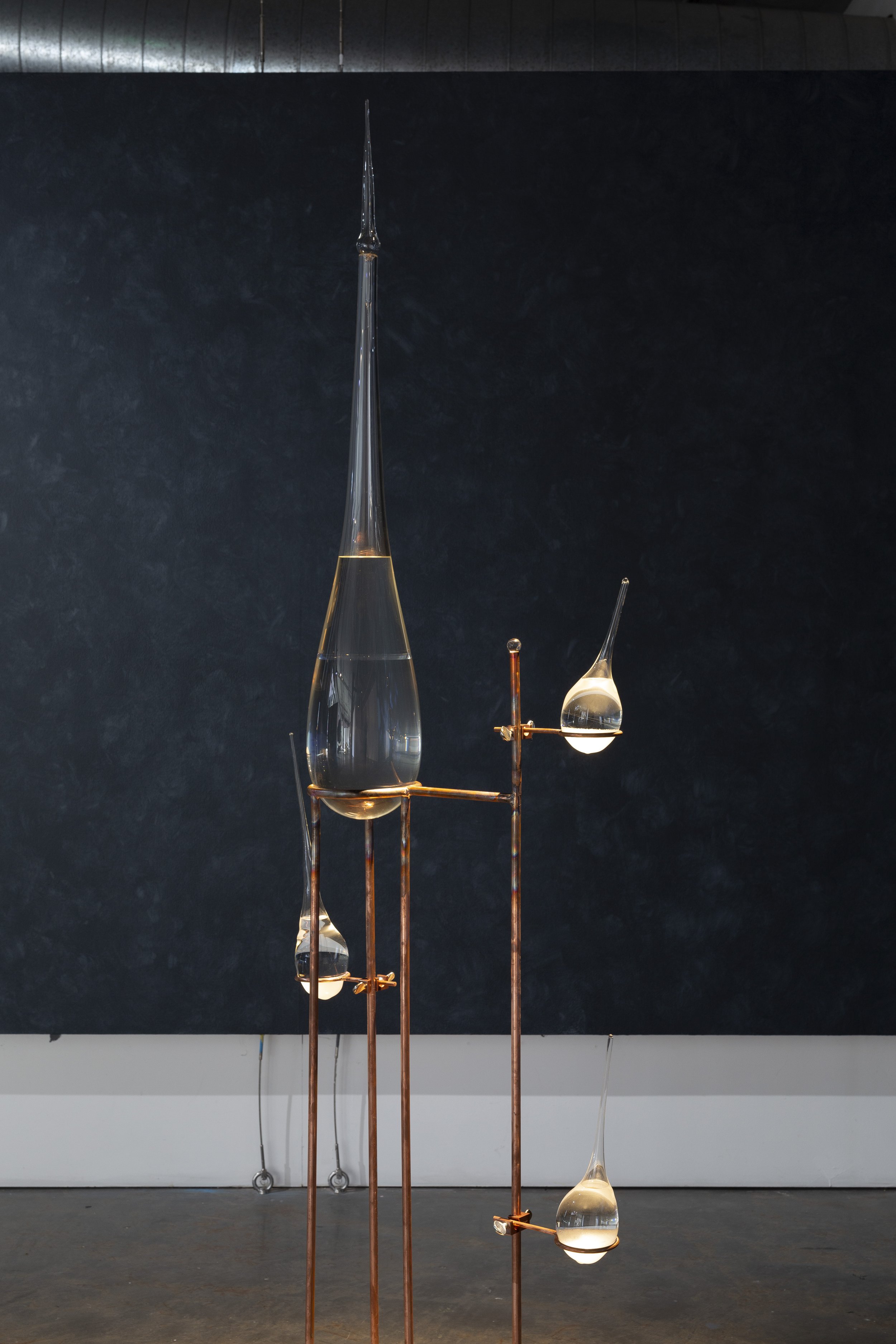ANNA MAY KIRK
’FORECASTING THE TOUCH OF CHANGE’
3 AUGUST-2 SEPTEMBER, 2022
Anna May Kirk, Forecasting the touch of change, 2022, video still. Photography by Daphne Nguyen.
ARTIST STATEMENT
Forecasting the touch of change makes imperceptible forces felt, heard, and seen. It produces a spectral encounter with climate change – a phenomenon that typically eludes our senses. From global weather systems to chemical disruptions invisible to the human eye, the exhibition responds to the many processes of climate change that act upon temporal and geographic scales beyond human visual perception.
The sculptures that inhabit Forecasting the touch of change are sensory in their nature, porously registering and responding to the world. Blown glass and copper ‘instruments’ sealed with the 19th-century chemical composition of a Storm Glass forecasts future weather. Like an oracle, their internal crystal structures evolve with atmospheric changes, predicting what lies ahead. In the air of the gallery, the scent of ozone from the upper atmosphere hybridises with petrichor from bacteria deep in the soil and the cracking sound of a distant storm reverberates through the space. Here, the ungraspable forces of macro- and micro-scales of change are made sensible within the body—they are breathed in, listened to, and felt.
Forecasting the Touch of Change proposes methodologies of attuning oneself to the immaterial nature of environmental change through the senses: breathing, listening, looking, and feeling. Through these experiences the body is embraced as a sensitive instrument for intimately encountering a transforming world, ultimately producing new manifestations of our molten planetary condition.
Anna May Kirk, Forecasting the touch of change, 2022, installation view, dimensions variable. Photography by Jessica Maurer.
Forecasting the Touch of Change
How do you contain the uncontainable? How do you compress a rapidly changing and radically warming world into something readable, something understandable—something, maybe even, knowable. These are not abstract questions. Instead, they suggest the limits of certainty in the age of knowing. They strike at the heart of our uneasy relationship with global warming: a phenomenon, which looms large in our collective consciousness, yet also resists the strength of this contemplation. Philosopher Timothy Morton has described global warming as a “hyperobject”—a phenomenon, which is simultaneously ubiquitous and elusive; present everywhere and yet nowhere to be seen. He writes that, “nowhere in the long list of catastrophic weather events […] will you find global warming. But global warming is as real as this sentence. Not only that, it’s viscous. It never stops sticking to you, no matter where you move on Earth.”[i] So, how do we find and hold on to this sticky, yet slippery, thing?
Anna May Kirk’s exhibition, Forecasting the Touch of Change, offers a strikingly different perspective from those that we have come to expect. Here, we find 21 storm glasses—and, among them, five main vessels, which contain a mixture of distilled water, ethanol, potassium nitrate, ammonium chloride, and camphor. Far from being inert, this alchemical blend triggers crystals to grow within each of the storm glasses. But these ever-shifting minerals are more than just decorative shards. Since the nineteenth-century, sailors have attempted to predict the weather and the movements of the ever-shifting winds by studying the storm glasses’ mutable crystal formations. Construed in more dramatic terms, we might say that these mariners sought to ensure their very survival at sea by looking inward and staring into the depths of the storm glasses. Popularised by admiral Robert FitzRoy—the man who captained Charles Darwin's voyage on the HMS Beagle and coined the very term “forecasting”—the shape of crystals purportedly suggest the conditions of the outside world. When the westerly wind blows, the crystals are well defined and clear, whereas a southerly wind will, according to FitzRoy, sink the mixture “downward in the vial, till it becomes shapeless, like melting white sugar.”[ii]
Anna May Kirk, Forecasting the touch of change, 2022, installation view, dimensions variable. Photography by Jessica Maurer.
The storm glass is an object that sits somewhere between science and superstition. On one level, we are looking at an antiquated technology whose efficacy has long been cast into doubt. On another, the handblown glass contains not only chemicals, but also harbours the enduring impulse of humans to import a sense of order into our chaotic world. Kirk’s work registers the atmosphere of the gallery, yet, more than that, it also records some essential part of us. In reaching back into history and intertwining it with the present, the storm glasses suggest the difficulty of knowing the world, as well as our unfaltering attempts at attaining this same knowledge.
Anna May Kirk, Forecasting the touch of change, 2022, installation view, dimensions variable. Photography by Jessica Maurer.
The space of the art gallery or art museum has a clear historical mandate: within its walls, sight is king. Knowledge, and, more than that, understanding, can only be attained with our eyes. You and I—the aptly named “viewer”—look at things. We are a floating gaze that briefly observes the spectacle of art before turning to the next work. This is the orthodoxy of most cultural institutions. Here, however, Kirk’s work moves to shift these expectations, by recognising and responding to the body as an expanded sensorial system. Historian Joy Parr writes that “our bodies are the instruments through which we become aware of the world beyond our skin, the archives in which we store that knowledge and the laboratories in which we retool our senses and practices to changing circumstances.”[iii] Forecasting the Touch of Change responds to this simple yet radical idea.
Anna May Kirk, Forecasting the touch of change, 2022, installation view, dimensions variable. Photography by Jessica Maurer.
As one moves through the gallery, they not only look at Kirk’s artworks but also breath them in. The space itself has an atmosphere—a weather system, if you will—that changes you as you move through it. Here, we smell an amalgam of two distinct scents, which have been diffused into the air and which Kirk created with perfumer Ainslie Walker. The first is petrichor; the familiar yet equally ineffable smell that comes after it rains and which emanates from the soil below. The second is ozone, whose scent almost fizzes like an electrical spark, recalling to us the skies above. Put simply, here, the essence of the sky and the earth intermingle.
Anna May Kirk, Forecasting the touch of change, 2022, installation view, dimensions variable. Photography by Jessica Maurer.
As the air in the gallery is breathed in, the audience's own lungs are filled and transformed into an extension of the exhibition, as the artworks are literally drawn into the body. A symmetry of action is created here: the artist exhales and blows molten glass in order to form the storm glasses, while the audience inhales and breathes in the space. Through breath, the audience both touches the work and is touched by it, literally changing their chemical physiology simply by the very fact of their presence. Through the simplest, yet most fundamental, of actions, the artwork silently urges us to move beyond the strictures of sight and come to know our ever-changing world differently.
The poetics of Kirk’s installation are both echoed and amplified in her video work. The piece, which she produced in collaboration with Daphne Thảo Nguyễn, reframes the crystals that sit inside the storm glass, so that they almost appear like a landscape of ice (echoing the quintessential image that has been deployed, time and time again, as a shorthand for the effects of global warming). In self-consciously tricking the viewer’s eye, the installation seems to suggests both the limitations and possibilities of this visual rhetoric. That is, it literarily plays with our very notion of perspective, as an infinite landscape is, in fact, contained within a finite space. The local object and the global phenomenon are represented in a single visual gesture—so that two realities exist, impossibly, within the same stream of moving images.
During the period that Kirk filmed the storm glass footage, another of her artistic collaborators, Alexandra Spence, used a radio receiver to record the movement of the surrounding atmosphere, capturing a combination of what is known as “sferics” and “tweeks.” The noises that suffuse the gallery space and crackle with intensity are the sounds of lightning strikes and atmospherics, which have been pulled towards the viewer from hundreds of kilometres away. Yet, standing in the gallery with our eyes closed, they also transport us. They allow us to travel into the clouds, transcend the landscape and traverse the skies. The artwork does all of this before returning us back to the ground, and back to a space that we recognise, but now, maybe, know a little differently.
Tai Mitsuji
[i] Timothy Morton, Hyperobjects: Philosophy and Ecology after the End of the World (Minneapolis: University of Minnesota Press, 2013), 48.
[ii] Robert FitzRoy, The Weather Book: a Manual of Practical Meteorology (London: Longman, Green, Longman, Roberts, & Green, 1863), 440.
[iii] Joy Parr, Sensing Changes: Technologies, Environments, and the Everyday, 1953-2003 (Vancouver: UBC Press, 2010), 1.
Roomsheet
Exhibition essay by Tai Mitsuji
PODCAST
In this episode, Anna May Kirk and Tesha Malott speak about anecdotes and precarious weather systems told by precarious positioned objects in the gallery. Anna is an artist, curator, creative producer and based in Sydney. She is interested in the representational issue posed by the immaterial and spectral nature of Anthropogenic climate change. Through sculptural glass and sensory installations, Kirk engages the beholder’s body as a sensitive and porous instrument for encountering the magnitude of environmental change. In her research-based practice Kirk entangles references vast times, intensities, and scales of our transforming planetary condition often investigating past moments of climate change throughout earth’s history in order to speculate on the uncertain future.






